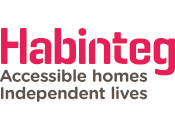
Adapting your home: managing cognitive impairment and behaviour that challenges
Adapting your home: managing cognitive impairment and behaviour that challenges

Sponsorship has no influence on our impartial content
Factsheet contents
- Introduction
- Cognitive impairment and dementia
- Using visual cues
- Making it easier to recognise things
- Making it easier to see things
- Lighting
- Floor coverings
- Using steps and stairs
- Disguising exits
- Using the toilet
- Using the bathroom
- Using the kitchen
- Using the bedroom
- Accessing the garden
- Behaviour that challenges
- Safety: reducing risks around the home
- Managing hazards in the kitchen and bathroom
- Sleep
- Décor
- Repetitive behaviours
- Sensory led behaviours
- Supervision
- Self harm
- Outdoor environments
- Provision of equipment
- Further advice from us
- Contributors
- Useful organisations and resources
- References and further reading
Introduction
There are disabilities which do not affect the ability of older and disabled individuals to physically complete tasks or activities but for which equipment or adaptations can make life easier. This fact sheet provides information on how to reduce the difficulties people experience linked to cognitive impairment, dementia and behaviours that are challenging.
Further information on adapting your home can also be found in the following DLF fact sheets:
The bathroom
The kitchen
Access into and around your home
Vision and hearing impairment or loss
Planning and funding
Cognitive impairment and dementia
A person with a cognitive impairment can become easily frustrated when they are unable to carry out simple everyday tasks or communicate their needs. They can become restless, anxious, appear to be behaving aggressively or depressed. They may have disturbed sleeping patterns. They may have a tendency to walk off and be unable to find their way home again. There are some simple inexpensive changes you can make in the home that can help to reduce or change this behaviour.
People with dementia may increasingly have problems with planning and concentration. Many people with dementia may be competent in every day living tasks, but become increasingly reliant on being reminded what they are doing.
This fact sheet focuses on the needs of those with dementia, but many of the strategies listed will help those with other causes of cognitive impairment.
Further reading: Also see DLF's range of fact sheets on Living with dementia.
Using visual cues
The combination of dementia and sight problems in old age can make it difficult to understand the world around you. People with dementia become increasingly reliant on simple visual prompts in the home environment to make it easier to find things and understand their environment - introducing these can reduce the need for verbal prompts and help from others. If there are obvious triggers and visual reminders, people with dementia can often do a lot more for themselves than you might expect. This can also reduce frustration and anxiety, improve confidence and enable people to experience a sense of competence in their every day lives.
Highlight key items and supplies
Keep essential items in view - for example: cup, kettle, and tea bags - out on the kitchen worktop, or alternatively you can use a shelf or glass fronted cupboard. Use see-through jars for coffee, tea, and sugar. Labelling drawers and the fridge to draw attention to essential supplies is also helpful.
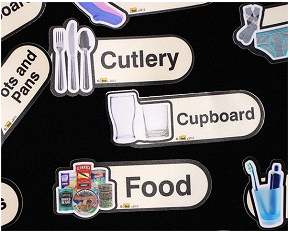 Conceal and secure storage of hazardous substances
Conceal and secure storage of hazardous substances
If there are concerns that hazardous substances may be misused it is best to keep these out of reach and/or stored away in locked cupboards.
Reduce unnecessary clutter and label cupboards and drawers
It can be helpful to leave things out on surfaces, so that they can found easier.
Also labelling cupboards and drawers can help in remembering where things are kept. You can make your own labels using post-it notes or self adhesive labels from specialist suppliers. Picture labels can be of benefit if reading has become more difficult.
Making it easier to recognise things
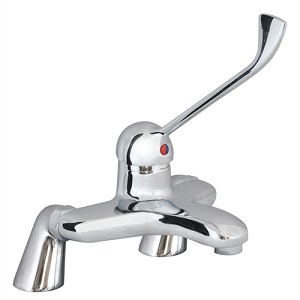 Many people with dementia will be able to continue to perform everyday tasks including washing, dressing and activities such as making a cup of tea if they can recognise key features in their home.
Many people with dementia will be able to continue to perform everyday tasks including washing, dressing and activities such as making a cup of tea if they can recognise key features in their home.
Taps
There are a huge range of different kinds of taps available now, but it is not always obvious how to operate them.
- Someone with dementia may not be washing because they do not understand or recognise the taps. Many may be more comfortable using traditional style taps rather than taps in a modern design.
- Many people with dementia may also have arthritis and struggle to turn taps. Some cross head taps for example are larger in design and can be easier to turn on and off. Lever mixer taps can offer a solution as they require less strength and flexibility of the wrist to operate
- Red and blue stickers could be used to highlight which taps are for hot and cold water.
Toilet flush
A basic lever toilet flush is more likely to be recognisable than the push button flush that is now more common. Many people with limited grip strength and dexterity also find lever flushes are easier to operate.
Making it easier to see things
Colour and tonal contrast can be used to make it easier to see and understand the space and layout, and to get around the home. Bright colours aren't necessarily required; the basic principle about tonal contrast is the difference between light and dark - e.g. a dark chair against a light wall will make the shape more recognisable and easier to see.
Areas where using tonal contrast can make it easier to see and understand the space:
- Door frames, handles and locks that are darker or lighter than the background wall
- Darker work surfaces can make it easier to pick out light crockery, cups, plates, chopping boards etc
- Walls that are lighter or darker than the furniture
- Floors that contrast to the skirting and walls, but also are continuous in tone between areas and rooms
- Bedding - e.g. a darker duvet with a white pillow can make it easier to see and understand that it is a bed
- A darker toilet seat against a white toilet bowl.
Lighting
Good levels of lighting can help with visual access and safety in task areas. This is especially important in kitchens and bathrooms where there is more risk when carrying out tasks.
Task lighting

- Increase light to twice normal levels in task areas. It is important that the light source is positioned so that the light is directed onto the area where the task is to be performed.
- Position the light source:
- Above a wash basin and around a mirror, for shaving and grooming
- Directly onto a kitchen surface for preparing meals or hot drinks
- Avoid positioning light sources behind the user that can cast a shadow onto the work surface or task area
- Shield the light source to avoid glare.
Storage lighting
- Lighting in drawers and cupboards can make it easier to locate items
- There are a number of simple battery-operated bolt on products available.
Maximising existing light sources
People can become disinterested in an activity if they cannot easily see what they are doing.
- Let more light into rooms during the day. Keep curtains clear of the windows, cut back any planting near windows
- Increase the number of light sources and wattage of bulbs (Make sure you check your lampshades are safe if you are increasing the wattage of bulbs)
- Consider using dimmer switch controls to tailor the lighting to suit the individual
- Use lighting to draw attention to and encourage engagement in activities
- Lighting can also be used to highlight personal items of significance, photos of people (family, friends) and places.
Operating switches and controls
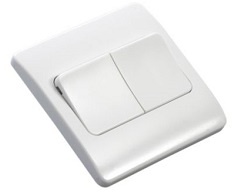
If lighting sources are improved, it is important that it is also easy to find and operate any switches:
- Highlight light switches with stick on contrasting label positioned around the switch
- Consider changing light switches for a larger design, for example a paddle switch.
Floor coverings
- Loose floor coverings, mats and rugs are trip hazards. Remove mats or rugs and ensure carpets are safely secured.
- Avoid large areas of shiny flooring that can cause slip hazards. They can also cause glare and confusing reflections
- Avoid a strong tonal contrast between the flooring from one area or room to another. For people with dementia a strong tonal contrast on the floor can be perceived as a step or a hole - this can cause people to stop abruptly, trip, fall or refuse to cross a threshold.
- Aim for a continuous tone in flooring so that there are not any abrupt changes from light to dark.
Using steps and stairs
- Ensure that there is good lighting on stairs. Avoid lighting that will cause the user to cast a shadow onto the stairs.
- Painting the skirting in a contrasting colour can make it easier to make out the shape and profile of the stairs. A *light reflectance value that has more than 30 tonal difference between the colour of the stair covering and the skirting is recommended
- If stair rails are required, ensure that these are also a good tonal contrast (LRV30) from the background.
*Many product retailers (paints, floor coverings, fabrics etc) should be able to provide you with the light reflectance value for different materials.
Further reading: DLF fact sheet Choosing equipment to get up and down stairs.
Disguising exits
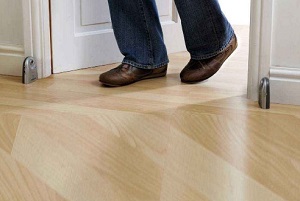 People with dementia can often be restless and may become frustrated by being confined to the house. For people with early dementia, a door exit sensor can provide reassurance to family members or a carer by alerting them in the event of someone not returning home when they should.
People with dementia can often be restless and may become frustrated by being confined to the house. For people with early dementia, a door exit sensor can provide reassurance to family members or a carer by alerting them in the event of someone not returning home when they should.
Where there has been concern about a person with dementia leaving the house, some Occupational Therapy assessments have suggested painting the front door the same colour as the door frame and surrounding walls - this can make it less obvious it is an exit. Plants and shrubs in the garden can be used to disguise or conceal the boundary fence, as can painting or disguising the garden gate so that it looks like the rest of the fence.
Further reading: Living with dementia: home safety and security
Using the toilet
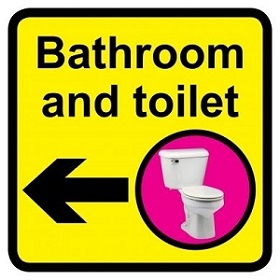 What might seem to be incontinence can often be just the case that people forget to go to the toilet or remember its location (this can be the case even if a person has lived in their home a long time). There are a number of changes that can be done to help to draw attention to the toilet and remind people to use it:
What might seem to be incontinence can often be just the case that people forget to go to the toilet or remember its location (this can be the case even if a person has lived in their home a long time). There are a number of changes that can be done to help to draw attention to the toilet and remind people to use it:
- Paint the bathroom door a strong contrast compared to other rooms
- Use signs with pictures of a toilet on the door as a reminder
- A toilet seat with a strong tonal contrast, e.g. dark wood, can help
- If you have a bedroom with an en-suite bathroom, leave the door open at night. Ideally it is good if you can see the toilet from the head of the bed - sometimes you can achieve this by changing the position of the bed.
- You can also leave the light in the bathroom on or fit sensors that will turn lights on if people should get out of bed during the night.
Further reading: Living with dementia: toileting and continence
Using the bathroom
Bathrooms are potentially dangerous for anyone who may be at risk of slips and trips, or could sustain injuries from scalding. Adjusting to age related difficulties with mobility and balance is more difficult for people with dementia, which puts them at higher risk of falls.
Shower adaptations
One of the first things that becomes most difficult as we age is getting in and out of the bath; the risk of a fall increases. A simple solution is to take the bath out and install a level access shower instead, which can be easier and safer for most people to use.
However, for people with dementia - and depending on how advanced the dementia is - a change to the bathroom can make it more confusing. When planning a shower adaptation for people with dementia, if possible, consider the following:
- Try not to change the basic layout: keep key features such as the toilet and washbasin in the same place
- Select shower controls that are simple and intuitive to use
- Look at models that can be programmed to switch off after a certain length of time, to prevent the water being left running after use
- Ensure the water temperature cannot exceed 43° C.
 Use strong tonal contrast to make it easier to understand the space and layout and pick out key items:
Use strong tonal contrast to make it easier to understand the space and layout and pick out key items:
- Rails that contrast to the walls
- A toilet seat that contrasts to the toilet bowl
- Walls, tiling and flooring that contrasts to white sanitaryware
- Shower controls that are distinct and easier to read and understand.
Consider using a sign or pictogram on the bathroom/toilet door or leave the door open.
Select matt tiling to avoid large areas of shiny surfaces on walls and floors that can cause confusing reflections and glare.
Further reading: DLF's fact sheets: Adapting your home: the bathroom and Living with dementia: showering and bathing
Flooring
- Select slip resistant flooring
- Avoid mats that can cause trip hazards
- Avoid patterned flooring that can be perceived as three dimensional or moving shapes - these can be disturbing to walk over
- Ensure the flooring is a continuous tone and there are no abrupt changes from light to dark that can be perceived as a hole or step - this can potentially cause a fall.
Familiarity
- Select taps that are familiar to operate, e.g. cross head taps
- Select a level toilet flush that can be easier to operate
Water temperature
Ensure the water temperature in taps and showers does not exceed 43° C.
Heating
Consider installing low surface temperature heaters/radiators to minimise the risk of burns (for example if there is a tendency to use radiator for support or in the event of a person falling and landing against the radiator).
Doors
Some people may lock themselves in a room. In the event of an emergency, or if someone falls or collapses for example, this can make it difficult to access the room.
- Consider changing the door to open outwards (check this does not cause an obstruction on the landing)
- Fit a door with a double hinge and lock that can be operated from outside.
Using the kitchen

- Minimise large areas of reflective surfaces that can cause confusing reflections and glare
- Provide task lighting that falls onto the worktop. Ensure that it not positioned in a way to create shadows
- Avoid patterned surfaces that can be perceived as three dimensional or seen to be moving
- An isolator switch, fitted out of reach, can be programmed turn off the cooker or hobs when not in use
- Ensure flooring is a continuous tone throughout and the same tone as the adjoining rooms. A strong contrast, e.g. from light to dark flooring, can be perceived as a hole or step and can cause a person to hesitate, trip or fall.
- Select taps that indicate hot/cold and are traditional in appearance and easy to use. Consider high loop taps that can be swivelled over onto the drainer to make it easier to fill a pan or kettle
- Consider the need for heat, smoke and carbon monoxide sensors and alarms. Most of these sensors can be linked to Telecare systems to alert carers.
Further reading: DLF's fact sheets
Living with dementia: food preparation
Choosing telecare
Adapting the home: the kitchen
Using the bedroom
Prompting dressing
A chest of drawers with cut outs or wardrobes with a glass fronted section and an internal light can help the user to see the contents and select garments and maintain independence with dressing and undressing.
Further reading DLF's fact sheet Living with dementia: dressing
Going to bed and waking at night
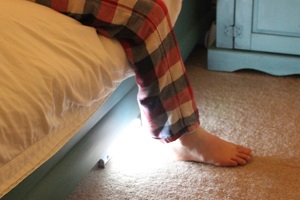 It is common for many people with dementia to have disturbed sleep and become more restless during the night. There are some simple things that can help to reduce this tendency.
It is common for many people with dementia to have disturbed sleep and become more restless during the night. There are some simple things that can help to reduce this tendency.
- Keep lighting low. Dim the lights to promote relaxation and help prepare for sleeping. Fit sensors that trigger a light to go on if the person should get out of bed
- Leave a light on in the bathroom so it is easy to find the toilet. If there is an en-suite, leave the door open so that the toilet is visible from the head end of the bed
- Use blackout blinds to make the room darker at night and encourage more regular sleeping patterns
- Consider a clear contrast between the pillow and the bedclothes to make it easier to recognise. Avoid patterned bedding or floor coverings that can be seen as three dimensional or moving and can be disturbing.
Further reading: DLF's fact sheet Living with dementia: sleep and night-time disturbances.
Accessing the garden
To make it as safe as possible for the person to go outdoors:

- Provide grab rails at steps and thresholds to help make it easier and safer to get inside and out
- Ensure that paths are even and free from uneven pavings that can cause a trip hazard. They should also be kept free from moss, leaves, or planting that can cause the surface to become slippery
- Consider providing areas of interest, e.g. bird feeders and water features, that can become a source of stimulation
- Consider raised beds or shelves for pots that are designed to be easier to reach to promote activities or help people who enjoy gardening to be able to continue to participate
- If possible, disguise exits and boundaries and/or increase heights of planting around the border to reduce the urge for people to leave the garden or climb over low walls and fences.
Further reading: DLF fact sheets - Adapting your home: access into and around your home
Behaviour that challenges
The causes of behaviours that can be challenging vary. They may be due to a condition such as Autism, a learning disability, or may occur after a head injury or an illness. As part of the aging process, a condition such as dementia may also cause changes to a persons’ behaviour and result in behaviour that is challenging. More information on dementia can be found above and in DLF's fact sheets, Living with dementia.
Understanding why someone displays behaviour that challenges will help towards managing this and altering the environment around them can reduce the likelihood of the behaviour occurring. Sometimes however it is not possible to find a cause of a behaviour, possibly because it does not occur immediately after a trigger, or because the person is unable to express what is upsetting them. Then the best response may be to ensure the behaviour does not put an individual or those around them at risk of harm.
Looking for cues which can cause behaviour that is challenging may be linked to a person's routine. It may be that disrupting a routine or an unexpected event will cause a behaviour that is challenging to be displayed. This is difficult to predict or manage, but being aware of ‘triggers’ and what will calm someone will help manage the behaviour.
For some, the triggers are linked to the five senses. If a texture, sound, smell, taste or something visual affects someone who cannot move away from it, cannot tell those around them of their dislike, or in some cases manage the fear they feel, they may display behaviour that is challenging. This could be someone who dislikes a particular colour or who finds a noise disorientating for example. A busy cluttered environment may be the trigger (Mostafa, 2010; Nagib & Williams, 2016), or an inability to understand how a space can be used for very different purposes (e.g. a bedroom used for play, personal care and for sleep).
An Occupational Therapy assessment and intervention may be recommended to consider how a person’s sensory needs can be met.
Safety: reducing risks around the home
If someone does not have an awareness of the risks associated with their behaviour this may mean they act in ways which place them at risk. It is not possible to watch someone 24 hours a day, so considering where an area of risk can be reduced will help.
Climbing and jumping
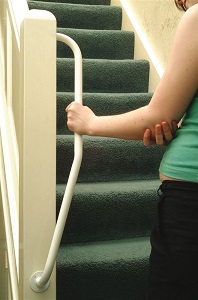 Staircases may be risky when someone is unable to visually assess depth (e.g. when you misjudge where the bottom step is located etc). Installing handrails on both sides of the stairs helps with balance, as will highlighting the front edge (nosing) of a step. Avoid highly patterned stair coverings as they can make it difficult for someone to judge where one step ends and the next begins. Well-lit stairwells, without areas of shadow, will also help.
Staircases may be risky when someone is unable to visually assess depth (e.g. when you misjudge where the bottom step is located etc). Installing handrails on both sides of the stairs helps with balance, as will highlighting the front edge (nosing) of a step. Avoid highly patterned stair coverings as they can make it difficult for someone to judge where one step ends and the next begins. Well-lit stairwells, without areas of shadow, will also help.
Climbing on bannisters presents a risk of a fall from height. It is possible to alter the spindles to ones which fill the gap between floor and ceiling, or the area could be fully enclosed. It may be preferable to have a door isolating the staircase from the surrounding area (Nagib & Williams, 2016)
If the concern is over jumping from the top to the bottom of the stairs, a stair gate can be considered. However, these may not be effective for older children and adults as they may be able to undo the latch and/or they may be able to climb or step over the stair gate.
Stair gates come in different designs and can be higher than standard - some can be up to 147cm tall with extensions. When considering if they are suitable to use, also think of other family members who may use it. Stepping through a reduced opening, often with a slight ‘lip’, may be a trip hazard for some.
Windows
N.B - Windows must never be permanently secured as they are essential exits in case of fire
If locks or lockable stays are used, the keys need to be kept in a suitable location close by in case of an emergency. Your local Fire and Rescue Service will be able to offer advice and information.
If the person climbs onto window sills, using existing window locks or installing new window locks is essential. Lockable window stays are recommended as these limit how far a window can be opened. Most window locks and stays do not need specialist tools to fit them, but if you are unsure, a family member or handyman service would be able to fit them for you.
If the roof design allows, installing roof lights may be a safer option. A steeply sloped infill can be fitted over a window sill which removes the surface and prevents it being stood on.
Adding a ventilated, clear, polycarbonate covering to windows can help prevent those with behaviours that are challenging from banging against the glass windows. In addition, blinds can be provided between the polycarbonate covering and window to control privacy and prevent the blinds from being pulled off. This can also remove the need for curtains.
Furniture
Where furniture is placed can create or reduce hazards - for example bookcases and shelves offer options to climb. Removing these or placing shelves at a higher level away from other items of furniture helps to reduce these options (Nagib & Williams (2016).
Exits
If a person who needs supervision outside of the home is able to leave the property, then a method of ensuring their carers are made aware of when a door has been opened, or preventing them from leaving the home, is needed.
If a person is unable to operate a door knob, changing a lever type handle to a door knob for example may be all that is required. Installing a second handle at a high level is an alternative solution, but this will affect other family members who may need to carry items and will not have a ‘spare’ hand available to comfortably use the handle. The position of a second handle also needs to take into account how tall other family members are, or if they have any arm or shoulder injury which would prevent them opening the door. This includes children who ordinarily would not need supervision away from the home.
Locking any exit doors is recommended for home security, but when a person is able to operate a lock and is unable to manage risks or avoid hazards, additional actions are needed. Using a door chain may help, but as these can be awkward to undo the impact on other family members must be considered. Replacing internal doors with stable doors is an option which limits someone’s ability to leave a room. This allows them to be observed while feeling less confined and aware of those around them. Any safety system which relies on locks needs a routine in place which all family members adhere to. In busy households that can be difficult to maintain.
Alternatively door alarms can either sound an alarm which is audible throughout the house, or have a portable unit that operates in the same way as a wireless doorbell. The suitability of these will depend on where the door leads to. If it is to a secure area or fully fenced garden this may be appropriate, but if it leads onto a road the risks are higher.
Restricting access to individual rooms
N.B - It is not appropriate to lock a person in their room overnight, even if this it to maintain their safety
If you are considering this as a last resort please seek advice from an Occupational Therapist working for the Local Authority and from the Fire and Rescue Service
At times, especially overnight, it may be necessary to restrict access to certain rooms, such as the kitchen or bathroom.
It is possible for specialist locks to be installed which are linked to a smoke or heat detector that will release automatically if a fire is detected.
There are regulations and procedures which have to be considered linked to deprivation of liberty for any individual, no matter how much risk they are in when unsupervised.
Heating
Radiators, stoves, freestanding heaters and fires all give off direct heat which may cause burns or be a fire hazard. If a person is unaware of the danger in touching a heat source or the long-term effect of contact with a radiator (even if it is not set at its highest temperature) measures can be put in place to minimise risk. Fireguards and radiator covers securely fixed in place prevent direct contact with heat but may offer another surface which can be climbed on.
Managing temperature through a central thermostat, rather than individual ones installed on radiators, will prevent the temperature being adjusted to an unsafe level. Modern combi-boilers often have a portable unit which may be more appropriate than a single wall mounted thermostat. Low surface temperature radiators or under-floor heating which reduces risk of burns can be installed. Alternatively consider installing radiators at higher levels, air-duct systems or systems which can be installed in the ceiling.
Electrics
 Plug socket inserts prevent items other than plugs being inserted into sockets. Where this is not sufficient, a lockable cover can be installed. Placing substantial items of furniture, such as a chest of drawers, in front of plug sockets which are in use may be enough, but this does affect access for others who may need to reach them.
Plug socket inserts prevent items other than plugs being inserted into sockets. Where this is not sufficient, a lockable cover can be installed. Placing substantial items of furniture, such as a chest of drawers, in front of plug sockets which are in use may be enough, but this does affect access for others who may need to reach them.
In an area where a person is unsupervised, such as in a bedroom overnight, it may not be appropriate to have sockets or electrical items installed. Light fittings which are flush to the ceiling are safer than pendant fittings. Installing the light switch outside of the room will also increase safety.
If music is enjoyed in the living room for example, then the radio or CD player can be set up outside the room. The speakers can then be installed in the room, wall mounted at high levels. Wireless speakers are an option, as they reduce the need for electrical items in the room. If a TV or music system is required, installing dedicated high-level sockets and mounting the TV/music system as high as possible, behind a toughened protective screen if necessary, should be considered. A cable tidy or cable bridge will help keep cables out of reach.
Managing hazards in the kitchen and bathroom
Hazards linked to the kitchen and bathroom include burns and drowning, or damage to the property such as through flooding.
Using a lock which can be operated by other family members who need to use these rooms will reduce the level of concern. If you cannot lock these rooms (such as a family with young children who need to use the bathroom but who cannot reach or operate a lock) it is possible to install isolation switches for water, gas and electricity. Ideally these will be outside of the room or the immediate area so their operation is not easily linked to the re-activation of a service such as water.
Simpler solutions which should be tried first are to unplug or switch off electrical items such as cookers, toasters and kettles. Also try plugs which sense when water will overflow or install additional stopcocks for water supplies which are then housed in secure areas.
Locks designed to prevent younger children from accessing cupboards and drawers are useful in keeping items such as knives secure. If these are not effective, specialist locks can be fitted which are released via a magnet, or for solid doors a ‘star’ lock can be installed.
Water
 Simple measures such as removing plugs from sinks or wash hand basins will help prevent floods and minimise the risk of drowning. If someone leaves taps running, installing push type fittings on the taps provides a set volume of water minimising the chance a hand basin will overflow. Stopcocks or specialist switches can also be installed.
Simple measures such as removing plugs from sinks or wash hand basins will help prevent floods and minimise the risk of drowning. If someone leaves taps running, installing push type fittings on the taps provides a set volume of water minimising the chance a hand basin will overflow. Stopcocks or specialist switches can also be installed.
The maximum water temperature can be set on boiler units but this may not be sufficient to minimise the risk of burns. Thermostatic taps and shower units can be installed which are pre-set to a safe temperature.
If excess water is splashed outside of the bath or shower area, specialist anti-slip flooring can be installed and if necessary an additional drain can be set into the floor to prevent flooding and damage to other areas of the house (Nagib & Williams, 2016).
Gas appliances
Modern gas appliances generally have automatic shut off systems if the gas is not ignited, or if the flame goes out. If the risk is that an appliance will be lit and left unattended, or if a person does not understand fire safety, removing the control knobs can prevent use or alternatively cut-off switches can be installed. Hob guards and oven door protectors are also available.
Sleep
People who display behaviours that are challenging may not have a good sleep pattern and therefore be awake and unsupervised during the night. The risks associated with this can be managed by promoting sleep and considering how to minimise risks.
Promoting sleep
Understanding why someone does not sleep through the nights is difficult. Setting a bedtime routine which reduces time spent watching TV or using a phone or tablet is recommended. Having a relaxing bath may help some. Even if this type of routine on its own does not work, maintaining it alongside other measures is encouraged. In some cases prescription medications such as Melatonin work for some people.
 Research has shown that for some white noise may assist with encouraging sleep patterns (Forquer & Johnson, 2005; Borkowski et. al., 2001). Recordings or apps which play this sound are available.
Research has shown that for some white noise may assist with encouraging sleep patterns (Forquer & Johnson, 2005; Borkowski et. al., 2001). Recordings or apps which play this sound are available.
Preferably the room where a person sleeps should be used solely for this purpose. Carrying out other activities, such as play or personal care for example, may lead to confusion and result in challenging behaviour disrupting a bedtime routine. Keeping a room clear of clutter or items such as toys helps with this - it may be that items are kept out of sight in cupboards or they may be best stored elsewhere.
Nightlights may be needed for some, whilst others will need full darkness. Blackout film, blinds and curtains can be fitted, but if these are a hazard or frequently pulled down, windows fitted with internal blinds can help. The blinds are raised and lowered by a magnet which runs down the window frame. NB - if these are required, the window will not be able to be opened to allow for ventilation as this will let light in.
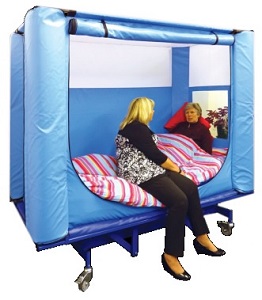 Where someone sleeps can have a great impact on how well they sleep. Placing a single bed against a wall rather than in the centre of a room is recommended (Mostafa, 2010) as this gives a sense of connection with the edge of the room. Some people may find the size of a double or king bed, or a bed with only the headboard against the wall disorientating, they may feel ‘marooned’. An enclosed space may support a good sleep pattern and so placing a bed in an alcove may provide the secure feeling needed to encourage sleep.
Where someone sleeps can have a great impact on how well they sleep. Placing a single bed against a wall rather than in the centre of a room is recommended (Mostafa, 2010) as this gives a sense of connection with the edge of the room. Some people may find the size of a double or king bed, or a bed with only the headboard against the wall disorientating, they may feel ‘marooned’. An enclosed space may support a good sleep pattern and so placing a bed in an alcove may provide the secure feeling needed to encourage sleep.
If a person seeks out small enclosed spaces such as cupboards, wardrobes or smaller rooms in their home, this may indicate that the sense of being enclosed is important to them. Before investing in an expensive option, it may be worth trying some simple strategies - for example placing a pop-up tent where it can be easily used. Bed canopies suspended from the ceiling are a high street option - which may be a cost-effective solution - although these, along with tents, should not be used if there is a risk associated with unsupervised use.
If it seems that a person needs an enclosed space in which to sleep and the high street options are not suitable, then other options are available. These are expensive and seeking advice and assessment from an Occupational Therapist is strongly recommended to ensure that the correct choice is made and the risks of their use are considered.
There are two types of equipment provision: adult sized cot beds and specialist tent like structures commonly called ‘safe spaces’. A fully padded room may be considered and information on this is included below in the section headed Self-harm.
Cot beds
 Cot beds are full sized beds which are fully enclosed.
Cot beds are full sized beds which are fully enclosed.
- Some systems can be placed on a standard or hospital type bed which fully enclose the bed, but these are more suitable for temporary use as they are unlikely to be robust enough for someone whose behaviour can be challenging
- Other models are designed to be placed directly on the floor and are fully padded. These are suitable for those who will not need assistance to get in or out, other than opening/closing the doors, and where personal care is not carried out on the bed (this is because this is not a good position for the person providing the care to be in and may cause injuries such as a bad back)
- Some models can be risen and lowered, with raising headrests similar to hospital beds.
The height options of the cot sides vary - these may be fully or partially padded, have spindles (dowels), Perspex or clear flexible sides. The access doors may be on one side or on both.
Your Occupational Therapist will offer advice and information on what aspects need to be included and how these beds should be used. N.B - they are designed for sleep only and not to manage any behaviour that is challenging that occur during the day.
Robust tent-like structures are an option, although funding for these is not always available. These structures can have a floor section which is suitable for sleeping on and may be used as ‘time out’ spaces during the day, however this may cause confusion when used at night. They are large in size and should not be dismantled and re-assembled. There are lots of different options that can be specified, depending upon the need of the person using it. Travel versions of these are available which can be transported to allow for nights away from home. Support for choosing a structure like this can be gained from an Occupational Therapist.
Where a cot bed or larger safe structure is being used, the Fire and Rescue service should be advised. In the event of an emergency they will need to know where these are being used, as additional time will be needed during an evacuation.
If someone displays behaviour that is destructive, there are companies that supply robust furniture, which although more expensive than standard items will withstand most behaviours that are destructive and can be cost effective in the long run. In some cases securing bedroom furniture to walls may also be useful. For some a mattress on the floor of an otherwise empty room may be the environment which suits them best, even though this for most people seems sparse.
Décor
Lighting
The amount and type of light produced may be uncomfortable for some people and may affect how they behave.

- Natural light is generally considered to be the best light source (Mostafa, 2010) but this should be indirect, rather than direct, as glare can be uncomfortable for some
- Lights which are operated by a dimmer switch allow for light to be adjusted to a comfortable level
- Fluorescent lighting is not recommended as the light flickers and a low humming noise can be omitted when in use which is known to be uncomfortable for those who are noise sensitive (Mostafa, 2010)
- Flush light fittings rather than pendants protect the bulb and limit the options for the fitting to be pulled from the ceiling.
Floor and wall finishes
 This is another area where a person may have strong preferences or dislikes, especially if they walk barefoot or prefer to sit or lie on the floor.
This is another area where a person may have strong preferences or dislikes, especially if they walk barefoot or prefer to sit or lie on the floor.
- In areas which may become wet, specialist anti-slip flooring can be fitted. However this may be uncomfortable for some who may prefer to wear sandals when bathing or showering
- Hard flooring is easier to clean and often more robust, but this reflects more sound making it a noisier environment.
- Carpets may be more comfortable for those who like to sit or lie on the floor, but keeping them clean is more difficult and they can be ingested or pulled apart. As well as comfort, carpet flooring has the benefit of reducing noise levels.
Noise
Noise levels and the type of noise which is tolerated or enjoyed varies from person to person.
- If someone is noise sensitive, increasing the window glazing to triple glazed units can reduce noise from outside, but only when windows are kept shut
- The noise from white goods, household equipment and extractor fans has been identified as uncomfortable for noise sensitive people. This can include the noise from water passing through central heating and plumbing systems. These noise sources are difficult to eliminate, but ensuring well-fitting doors separate these from family rooms and these are closed when equipment is in use, can help minimise the impact of their noise.
Where any behaviour that is challenging involves damaging or throwing household items, all glazing - including mirrors and in picture frames - should be toughened or tempered glass. Screen protectors can help protect TV’s and computers.
Repetitive behaviours
Repetitive behaviours can be soothing for some and a stimulus for others, but some actions have risks which need to be managed. It is worth noting that if a risky behaviour is limited or prevented it is likely that another behaviour will replace it.
- If the behaviour creates noise such as banging on a radiator or slamming a door, fitting a radiator cover or inserting a door wedge at the top of the door may reduce the noise level. An alternative is to install hydraulic door closers
- Where the behaviour involves gas, electric or water the suggestions included in the relevant sections above may assist in identifying a suitable solution.
Sensory led behaviours
We all have preferences or dislikes linked to the five senses: touch, taste, hearing, sight and smell. We enjoy particular foods due to their taste, smell and the texture in our mouths and we select colours for our homes that we enjoy. We are now beginning to understand how this affects everyone’s life (Brown & Gemeinboeck, 2018) but for some the impact is much greater.
Each sense may be experienced in an extreme (hyper) or minimal (hypo) way. Some behaviours that are challenging may be to avoid a sensation most people enjoy or are able to disregard. An example is the noise from an extractor fan. Most of the time we can ignore the noise, but perhaps notice it more at night when there aren’t other noises masking the sound. For some, the pitch of a sound will be so uncomfortable it has to be avoided. Noise eliminating headphones or masking noises may help, but the key will be to identify what is causing the distress or discomfort.
Where someone feels sensations in a more muted way than most (imagine being wrapped in cotton wool the whole time) they may seek out or create more intense sensations. This could be by creating loud noises, making lights flicker by switching them on and off or creating vibrations by operating the washing machine door, even when it isn’t needed.
It is difficult to identify which of the senses are leading a behaviour that is challenging and how to replicate this in a safe way, as this is specific to each of us. There are some excellent resources available such as www.autism.org.uk/sensory which offer advice and information that can be useful for those without a diagnosis of Autism, Asperger’s Syndrome or ADHD, and at any age.
Supervision
It may be that someone requires supervision at all times to ensure they remain safe. This is not possible in the home environment, therefore strategies are needed to help parents and carers. There has to be a balance found between safety and the privacy and dignity of a person.
- Baby listeners/alarms are widely available and are designed to be easily installed
- Home CCTV systems can be installed, but may not be appropriate for areas such as the bathroom and toilet.
- Internal windows between rooms can offer an unobtrusive way of observation as can vision panels in doors. Door viewers (as installed in many front doors) can give a 360° view of a room and enable monitoring without disturbing a person’s sleep. Having a light on a dimmer switch operated from outside a room allows for the light level to be raised enough to check on someone at night without the need to open the door.
Self-harm
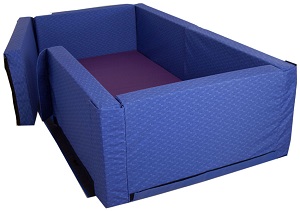
- This may be linked to sensory needs or a frustration at being unable to express something. If the self-harm is through using objects to injure themselves, then removing these or locking them away may help
- Head-banging behaviour may be managed through prescription of a helmet which is worn during the day. This cannot be used at night, therefore a padded cot bed, ‘safe space’ or padding the bedroom walls may be needed
- It may be possible to encourage a person who head-bangs to move to a safer environment once they are familiar with it. If not, avoiding furniture with sharp corners and hard edges is recommended. Carpets are a softer floor covering than other floor finishes, especially stone or tiled floors.
Outdoor environments
Being outdoors has been noted as beneficial for many people with behaviours that are challenging (Hartig & Cooper-Marcus, 2006).
- Enclosing a garden helps ensure a person remains within it. Fencing should be at least 6ft high and selected so the design does not offer hand and footholds. Vertical feather boards provide few hand holds, but can be prised from the horizontal support unless securely attached. Specialist anti-scale fencing is available but is expensive and may require planning permission
- Planting in the garden may provide scents and sounds which are pleasing. If a person is led by taste or by experiencing sensations from ‘mouthing’ or chewing items, plants should be chosen with care as many everyday flowers are poisonous. That said, a sensory garden may be a soothing place to be and gardens can offer enjoyable sensations, such as the light filtering through leaves and natural sounds
- For those who enjoy the sensation of bouncing or jumping, installing a trampoline with a net surround or inset into the ground allows for exuberance for example to be displayed in a safe manner.
Provision of equipment
There are a few options available for funding of equipment and minor adaptations; this can vary across the UK. We provide an overview of the options available here, but it is worthwhile checking what arrangements are in place locally.
In England, if you are assessed as requiring preventative intervention, equipment under £1000 would be free of charge to you (Department of Health 2014, section 2.9). In Scotland, Local Authorities make their own arrangements for provision of minor adaptations and details can be accessed via your Council website. If the equipment or adaptation costs more that £1000, you may have to apply for a Disabled Facility Grant (Mandelstam 2016).
The Money Advice Service has some useful information about funding for adaptations.
It is recommended that you seek advice from an occupational therapist before considering which equipment is suitable to you. You may be entitled to an assessment by a Local Authority Social Services Occupational Therapist. Alternatively a list of independent Occupational Therapists can be found on The Royal College of Occupational Therapists' website.
Private purchase
If you need advice before you buy, contact your local equipment demonstration centre where you would have the opportunity to try out a range of equipment. There are several of these around the country where you can go for impartial advice. Your local authority will also be able to supply information about where your nearest centre is located. Also Disabled Living Centres and some retailers have showrooms which have areas set up so you can try out items of equipment to see if they will suit you before you commit to making a purchase.
If you are unsure if you can afford the equipment or any of the associated costs, requesting an assessment or advice from an Occupational Therapist or local well-being service (local areas may have different titles for support services) will help with decision-making. It may be that another way of accessing equipment is more suitable for you.
Also consider if you can afford a service contract for more complex items of equipment. These may seem expensive at first but in the long run call out costs or replacements may prove to be costly. Some items such as hoists and slings need to be ‘LOLER’ (Lifting Operations and Lifting Equipment Regulations, 1998) checked. This is because they are used to move people mechanically and these checks are a legal requirement every six months. Others with moving parts or electrics will have a service schedule recommended by the manufacturer which is included in the instruction manual.
Before purchasing, look for a sales company that belongs to a trade association, such as the British Healthcare Trades Association (BHTA). BHTA members have signed up to a code of practice governing standards of customer service (further details are given in the Useful organisations and resources section).
Some suppliers will fit equipment, but some is sold ‘supply only’. Finding a tradesman to fit items may not be easy. There may be a local arrangement for fitting small items such as a care and repair service or Home Improvement Agency or there may be a list of ‘trusted traders’ provided. Websites such as Checkatrade provide feedback from previous customers which can help you find a reputable service provider and Trading Standards may be able to advise if there are concerns over a company you are considering using.
VAT exempt purchases
Equipment which is specifically designed for those with disabilities may be purchased ‘VAT free’. N.B - this is not claimed back via the personal tax system / HMRC, but during your purchase. If you have purchased something which should have been VAT free, it is not possible to claim this back from the supplier or HMRC.
Equipment suppliers may have the VAT exemption form on their website or you can download a general form from the GOV.UK website. You will need to fill in a form for each supplier you use, but you will only need to do this for the first purchase with them.
Disabled Facilities Grants (DFGs)
A local authority Disabled Facilities Grant, often referred to as a DFG, may be available for essential home adaptations for you as a disabled person, if they are deemed ‘necessary to meet your needs’ and the work is ‘reasonable and practical’. This can include extensions and structural work to accommodate fixed hoists, stairlifts, downstairs bathrooms, shower units etc. If this type of adaptation is needed, a local occupational therapist will come to assess your needs and then contact the relevant council departments. The occupational therapist’s recommendations are taken as evidence that the work proposed is appropriate and meets all the requirements for funding.
The occupational therapist will be able to explain the application process. Information is also available from your local authority and on the Government website.
Disability Rights UK have some very comprehensive online information about DFGs and other housing grants.
DFGs operate across England, Wales and Northern Ireland. Conditions for DFGs will vary according to the country in which you live. For details of schemes in Scotland see Disability Information Scotland and Scottish Government (2009) Help with adaptations to your home: A guide for disabled people in private housing in Scotland. Edinburgh: Scottish Government.
Please note that you may not receive any grant if you start work on your property before the council approves your application.
Charitable funding
If you do not have the funds to buy equipment it may be possible to request support from a charity. They will usually have criteria which they will apply, and most will not consider equipment which should be provided by the NHS or Social Services.
Some charities will only consider requests which are supported by an involved professional, usually an occupational therapist, physiotherapist or a nurse. This may require them to be present during the assessment for an item of equipment. This is to ensure that the equipment is appropriate and will not have an impact on planned treatment or rehabilitation programmes.
Equipment is not always purchased outright and gifted to you. Some items are provided on loan, either for a specified length of time, or to be returned when no longer needed or appropriate for use.
A number of charity websites that offer funding are listed here:
- Community Care A list of charities giving grants
- Turn2us Turn2us is a national charity that helps people in financial hardship gain access to welfare benefits, charitable grants and support services.
- My grants Accessibility grants for disabled and older people
- Grants for individuals The Grants for Individuals website is run by the Directory of Social Change and lets subscribers search for grants. It is intended for organisations searching for funding on behalf of individuals.
Prescriptions
Following an assessment some local authorities will issue you with a prescription for the equipment that you need. This can be taken to a local retailer (usually a pharmacy or independent equipment retailer) and you can collect the equipment and begin to use it immediately. Usually there is the option to have the equipment delivered to your home if you have difficulty accessing your local retailers.
Equipment hire
If your need is short term it may be cost effective to hire equipment.
Mobility Hire for example is a national source for mobility and assistive equipment on hire or purchase. They offer short or long term rental solutions to meet most requirements – equipment ranges from wheelchairs to bathroom aids.
If the equipment is required for a holiday it is advisable to look for a supplier near to your destination – they will be able to respond to any issues such as a breakdown / breakage.
NB - equipment from Social Services is provided for use at your home address and should not be used elsewhere as:
- it is assessed as suitable for use in your home and selected to work with your bath / bed / toilet type
- they will not be able to respond to breakdowns or repairs.
However, if you are permanently moving home into the area of another local authority, you can take the equipment with you if you still need to use it and it is the most cost effective solution. You will need to discuss this with the service that issued the equipment to you.
Community equipment store loan
This is available via an NHS employee (Nurse / Occupational Therapist or Physiotherapist) or via a Social Services Occupational Therapy Service.
Loans can either be short term to assist after an operation or illness or longer term to promote independence or support care-giving.
Long term loans are usually the responsibility of Social Services (Adult Social Care / Children’s Services) and will be provided following an assessment by an Occupational Therapist. Straightforward items, such as raised toilet seats or bath seats and boards can be provided by an occupational therapy assistant. Arrangements vary across the UK and you may find that local arrangements allow different services to provide equipment on behalf of each other.
Also, equipment may be offered as an alternative to an adaptation. Your occupational therapist will explain why they are making this suggestion.
DLA / PIP / Attendance Allowance
Disability Living Allowance, Personal Independence Payments and Attendance Allowance are benefits available for those who need support with activities of daily living. Which of these can be claimed depends on the age of the person claiming the benefit. Information on claiming these is available from GOV.UK and the Citizens Advice Bureau - this website has advice specific to each of the home nations and enabling you to check your eligibility if you are not already claiming one of these benefits.
Further advice from us
For clear, practical advice and information on products and suppliers of daily living equipment, please have a look at our Living made easy website.
If you would like further advice related to choosing equipment for everyday living you could try relevant sections of AskSARA, our free online guided advice tool. AskSARA will ask you questions about yourself and your environment and then offer relevant advice, product suggestions and supplier details.
You can contact the DLF Helpline, which is open Monday to Friday from 10am to 4pm. Tel: 0300 999 0004 (calls charged at your standard land line rate even if you are phoning from a mobile).
Alternatively, you may wish to contact us via email: info@dlf.org.uk or by letter: DLF, 34 Chatfield Road, Wandsworth, London SW11 3SE.
To help us give you a concise and informative reply, please provide us with as much detail as possible, including information on the difficulties you are having and any solutions you have considered, such as equipment ideas.
Another source of advice is a disabled or independent living centre where you would have the opportunity to try out a range of equipment. There are several of these around the country where you can go for impartial advice. Your local authority will also be able to give you details of centres in your area.
Contributors
Marney Walker DipCOT, BA, MA
 Marney Walker is an independent occupational therapist specialising in the design of inclusive and accessible housing. She has over 25 years’ experience in the public sector, principally in housing and social care. Marney has an MA in Inclusive Design and has delivered training and taught at Masters level on the subject. She is an Inclusive Design Assessor for the Civic Trust, a member of the Access Association and London and South East Representative for Royal College of Occupational Therapy-Specialist Section in Housing.
Marney Walker is an independent occupational therapist specialising in the design of inclusive and accessible housing. She has over 25 years’ experience in the public sector, principally in housing and social care. Marney has an MA in Inclusive Design and has delivered training and taught at Masters level on the subject. She is an Inclusive Design Assessor for the Civic Trust, a member of the Access Association and London and South East Representative for Royal College of Occupational Therapy-Specialist Section in Housing.
Ruth Parker
 Ruth Parker qualified as an occupational therapist in 1985 working in roles within the NHS until 2001 when she moved to work in Adult Social Care. In 2005 she moved to her current team working with children with disabilities, their families and carers, supporting independence and care provision in the home. Ruth completed an MSc in Accessibility and Inclusive Design in 2010. Following this she has been working towards a PhD which utilises her experience working with children with disabilities to consider how design choices can affect the play experiences offered by play parks completing this work in December 2018.
Ruth Parker qualified as an occupational therapist in 1985 working in roles within the NHS until 2001 when she moved to work in Adult Social Care. In 2005 she moved to her current team working with children with disabilities, their families and carers, supporting independence and care provision in the home. Ruth completed an MSc in Accessibility and Inclusive Design in 2010. Following this she has been working towards a PhD which utilises her experience working with children with disabilities to consider how design choices can affect the play experiences offered by play parks completing this work in December 2018.
Lucy Leonard
 Lucy Leonard qualified as an occupational therapist in 1999 and gained an MSc in Advanced Occupational Therapy in 2015. Lucy has always worked in a community setting where she developed skills in equipment and adaptations for adults with complex, long term and neurological conditions. In more recent years, Lucy has worked as a clinical specialist occupational therapist with children and families recommending complex adaptations to meet children’s long term needs. Lucy also provides specialist occupational therapy assessments, recommending equipment and adaptations on behalf of charities and third sector organisations.
Lucy Leonard qualified as an occupational therapist in 1999 and gained an MSc in Advanced Occupational Therapy in 2015. Lucy has always worked in a community setting where she developed skills in equipment and adaptations for adults with complex, long term and neurological conditions. In more recent years, Lucy has worked as a clinical specialist occupational therapist with children and families recommending complex adaptations to meet children’s long term needs. Lucy also provides specialist occupational therapy assessments, recommending equipment and adaptations on behalf of charities and third sector organisations.
Useful organisations and resources
New Loom House
Suite 4.06
101 Back Church Lane
London, E1 1LU
The BHTA is the largest trade association for suppliers and manufacturers of mobility and homecare products. They have a code of practice to which their members sign up. Contact the BHTA to obtain a list of members in your area.
20-21 Red Lion Court
London EC4A 3EB
The Centre for Accessible Environments (CAE) is the UK's leading authority on inclusive design. Their aim is to help secure a built environment that is usable by everyone, including disabled and older people.
Unit 9, The Renewal Trust Business Centre
3 Hawksworth Street
20-21 Red Lion Court
Nottingham, NG3 2EG
Website: careandrepair-england.org.uk
Telephone: 0115 950 6500
Email: info@careandrepair-england.org.uk
Website: careandrepair-england.org.uk
Care and Repair is a small, national charitable organisation set up in 1986. It strives to: ensure that more older people can live independently and with dignity in their own homes for as long as they wish, connect housing, health and social care in ways that improve older people’s whole quality of life and work with older people to influence decisions about housing and the related services which affect their lives.
1st Floor, Mariners House
Unit A, Trident Court
East Moors Road
Cardiff, CF24 5TD
Telephone: 02920 107580
Website: www.careandrepair.org.uk/en/
Care and Repair helps older people in Wales live independently in their own homes, delivering practical help to create safe, warm and accessible homes.
Suite 2.5
Unit A, Trident Court
135 Buchanan Street
Glasgow, G1 2JA
Telephone: 0141 221 9879
Website: www.careandrepairscotland.co.uk
Care and Repair services operate throughout Scotland to offer independent advice and assistance to help homeowners repair, improve or adapt their homes so that they can live in comfort and safety in their own community.
3rd Floor
89 Albert Embankment
London SE1 7TP
Email: info@firststopcareadvice.org
Website: www.firststopcareadvice.org.uk
FirstStop Advice is an independent, impartial and free service offering advice and information to older people, their families and carers about housing and care options for later life. The service is provided by Elderly Accommodation Counsel (EAC) in partnership with a number of other national and local organisations, and brings together a wealth of expertise to help older people explore the options and choices open to them.
Foundations is appointed by the Department of Communities and Local Government to oversee a national network of nearly 200 home improvement agencies (HIAs) and handy person providers across England. HIAs are locally commissioned services that ensure people are able to stay safe, secure and warm and retain independence in their own home. They offer holistic services to their clients, helping to improve a person’s well-being, as well as offering practical solutions around the home.
Website: www.grantsforindividuals.org.uk/default.aspx
The Grants for Individuals website is run by the Directory of Social Change and lets subscribers search for grants. It is intended for organisations searching for funding on behalf of individuals.
Website: www.gov.uk
GOV.UK is the website for the UK government. It's the best place to find government services and information. GOV.UK has a section devoted to providing information for older adults and individuals with a disability.
Further reading:
Care Act fact sheets
Social Services and Wellbeing Act (Wales)
Chronically Sick and Disabled Persons (Northern Ireland) Act 1978 (delivered by the National Archives
Apply for a needs assessment by social services
London Head Office
Holyer House
20-21 Red Lion Court
London EC4A 3EB
Telephone: 020 7822 8700
Email: info@habinteg.org.uk
Website: www.habinteg.org.uk
Habinteg Housing Association champion inclusion and promote accessible homes and neighbourhoods. They also complete research and publications and are actively involved in policy making.
Telephone: 020 7822 8700
The Home Adaptations Consortium is made up of a broad spectrum of national organisations working together with a single aim: to champion quality provision of home adaptations for disabled people. It was initiated in 2008 by Care & Repair England to provide a forum to share and promote good policy and practice. The Consortium aims to identify and highlight the potential impact of wider policy changes e.g. in social care and health reform on the provision of home adaptations and Disabled Facilities Grants (DFGs). The Consortium only operates in England.
Website: www.moneyadviceservice.org.uk
Money Advice Service offer free and impartial money advice, set up by government. Further reading: Major or minor adaptations
Website: www.planningportal.gov.uk
Planning Portal is the first port of call for anyone wanting to find out about the planning system in England and Wales. Its aim is to provide a one-stop-shop supplying answers, services and information to anyone involved in the planning process - from home owners and businesses to planning professionals and Government officials. Further guidance and regulations about access to and use of buildings (Part M): www.planningportal.gov.uk/buildingregulations/approveddocuments/partm/approved
Ground floor, Unit 10, Blenheim Court
62 Brewery Road
London N7 9NY
Telephone: 020 7427 2460
Email: mail@ridc.org.uk
Website: www.ridc.org.uk
RiDC (formerly Ricability), the Research Institute for Disabled Consumers, are a national research charity dedicated to providing independent information of value to disabled and older consumers. Their reports are based on rigorous research and provide practical information needed by disabled and older consumers.
105 Judd Street
London, WC1H 9NE
Telephone: 0303 123 9999
Email: helpline@rnib.org.uk
Website: www.rnib.org.uk
RNIB offers help and support for blind and partially sighted people, from practical and emotional support through to campaigning for change. Further reading: Adapting your home, Practical adaptions.
Tavistock House South (Entrance D)
Tavistock Square
London WC1H 9LG
Telephone: 020 8995 0880
Email: info@pocklington-trust.org.uk
Website: www.pocklington-trust.org.uk
The Thomas Pocklington Trust is dedicated to improving the lives of people who are blind or partially sighted. Their guides offer advice and information on home adaptations, interior design, lighting and more for people with sight loss.
Released April 2019, to be reviewed by April 2022, Version 1
References and further reading Show references
Housing Lin Early Stage Dementia – A Carers Guide to creating a dementia friendly home by Age Scotland (2018). Available from www.housinglin.org.uk/Topics/type/Early-Stage-Dementia-A-carers-guide-to-creating-a-dementia-friendly-home
Housing Learning and Improvement Network (Housing LIN) Tools and Resources relating to Housing and Dementia https://www.housinglin.org.uk/Topics/browse/HousingandDementia/Design/
Barrett, J (2012). Provision for people with dementia within Housing with Care: Case studies from HDRC Steering Group Providers. Available from housingdementiaresearch.wordpress.com/publications
Dementia Services Development Centre (2014) 10 Helpful Hints for Dementia Design at Home: Practical Design Solutions for Carers Living at Home with Someone Who Has Dementia. University of Stirling
(2010) Light and Lighting for People with dementia.
(2013) Improving the design of housing to assist people with dementia.
Fuggle, L (2012) Designing interiors for people with dementia. University of Stirling Fuggle, 4th Ed.
Virtual Care Home. An online interactive tool that illustrates good practice in design for people with dementia. The layouts of seven individual rooms are modelled with information revealed interactively on how the features can make a difference for people with dementia. Available from dementia.stir.ac.uk/virtualhome
Greasley-Adams, C, Bowes, A, Dawson, A, McCabe, L. (Eds.) (2011). Good Practice in Design for Dementia and Sight Loss Thomas Pocklington Trust and University of Stirling. Available from dementia.stir.ac.uk/design/good-practice-design-dementia-and-sight-loss
Grey, T, Pierce, M, Cahill, S, and Dyer, M. (2015) Universal Design Guidelines. Dementia Friendly Dwellings for People with Dementia, their Families and Carers National Disability Authority (NDA) Centre for Excellence in Universal Design. School of Social Work and Social Policy: Trinity House Dublin.
Available from universaldesign.ie/Web-Content-/UD_Guidelines-Dementia_Friendly_Dwellings-2015-Introduction.pdf
Housing and Dementia Research Consortium (HDRC). Available from housingdementiaresearch.wordpress.com/publications
Inclusive Design for Getting Outdoors. Available from www.idgo.ac.uk
Social Care Institute of Excellence (SCIE) Dementia-friendly environments. Available from www.scie.org.uk/publications/dementia/environment/index.asp
NHS Choices Dementia Guide: How to make your home dementia friendly. Available from https://www.nhs.uk/conditions/dementia/home-environment/#better-lighting-can-help-people-with-dementia
The King's Fund Environmental Assessment Tools. A suite of dementia friendly assessment tools for use in care homes, housing, health centres, hospitals and wards. Available from https://www.worcester.ac.uk/discover/kings-fund-environmental-assessment-tools.html
Thomas Pocklington Trust. Lighting and design for older people with sight loss. Available from http://www.pocklington-trust.org.uk/research/lighting
Marshall, M (2011) Designing Balconies, Roof Terraces and Roof Gardens for People with Dementia by Mary Marshall. Dementia Services Development Centre.
Powell, J, Mackintosh, S, Bird, E, Ige,J, Garrett, H, Roys, M, (2017) Room to improve: The role of home adaptations improving later life, Centre for Ageing Better, University of West England and BRE. Available from www.ageing-better.org.uk/publications/room-improve-role-home-adaptations-improving-later-life.
Housing21, (2011) Creating Better Living Environments for People with Dementia. Housing 21, Beaconsfield. Available from www.housing21.co.uk/index.php/download_file/view/679/
HRDC (2010) Living beyond Dementia and Housing with Care. Housing and Dementia Research Consortium (HRDC) http://housingdementiaresearch.files.wordpress.com/2011/01/living-beyond-dementia-printer-friendly2.pdf
Pollock, A and Marshall, M (eds.) (2012) Designing Outdoor Spaces for People with Dementia. Dementia Services Development Centre, University of Stirling;
Brown, S and Gemeinboeck, P. (2018). Sensory Conversation: An Interactive Environment to Augment Social Communication in Autistic Children. In Assistive Augmentation (p131-150). Springer, Singapore.
Forquer, L.M, and Johnson, C.M, 2005. Continuous white noise to reduce resistance going to sleep and night wakings in toddlers. Child & family behavior therapy, 27(2), pp.1-10.
Hartig, T. and Marcus, C.C., 2006. Essay: Healing gardens—places for nature in health care. The Lancet, 368, p.S36-S37.
NHS Choices (2018). Dealing with challenging behaviour. Available from www.nhs.uk/conditions/social-care-and-support/challenging-behaviour-carers/
AskSARA
If you would like further advice regarding daily living equipment related to choosing equipment for everyday living you could try relevant sections of AskSARA. AskSARA is our free online guided advice tool. AskSARA will ask you questions about yourself and your environment and then offer relevant advice, product suggestions and supplier details.
| Attachment | Size |
|---|---|
| 29.51 KB | |
| 32.28 KB | |
| 21.79 KB | |
| 573.13 KB | |
| 21.11 KB | |
| 73.16 KB | |
| 29.82 KB | |
| 77.66 KB | |
| 68.66 KB | |
| 28.63 KB | |
| 126.16 KB | |
| 14.3 KB | |
| 111.2 KB | |
| 77.34 KB | |
| 7.21 KB | |
| 19.72 KB | |
| 32.15 KB | |
| 29.51 KB | |
| 46.71 KB | |
| 22.92 KB | |
| 11.23 KB | |
| 42.56 KB | |
| 809.1 KB |
All rights reserved. No reproduction or transmission of this publication may be made without written permission. Inclusion (including any sponsorship) does not indicate endorsement or that any item has been recommended or tested. All information is provided without legal responsibility.
Disabled Living Foundation, Tel: 020 7289 6111, Fax: 020 7266 2922, Helpline: 0300 999 0004 10.00am-4.00pm, Email: helpline@dlf.org.uk, Website: www.dlf.org.uk
Reg. Charity No: 290069, VAT Reg. No: 226 9253 54
 (Tell me about the standard)
(Tell me about the standard)
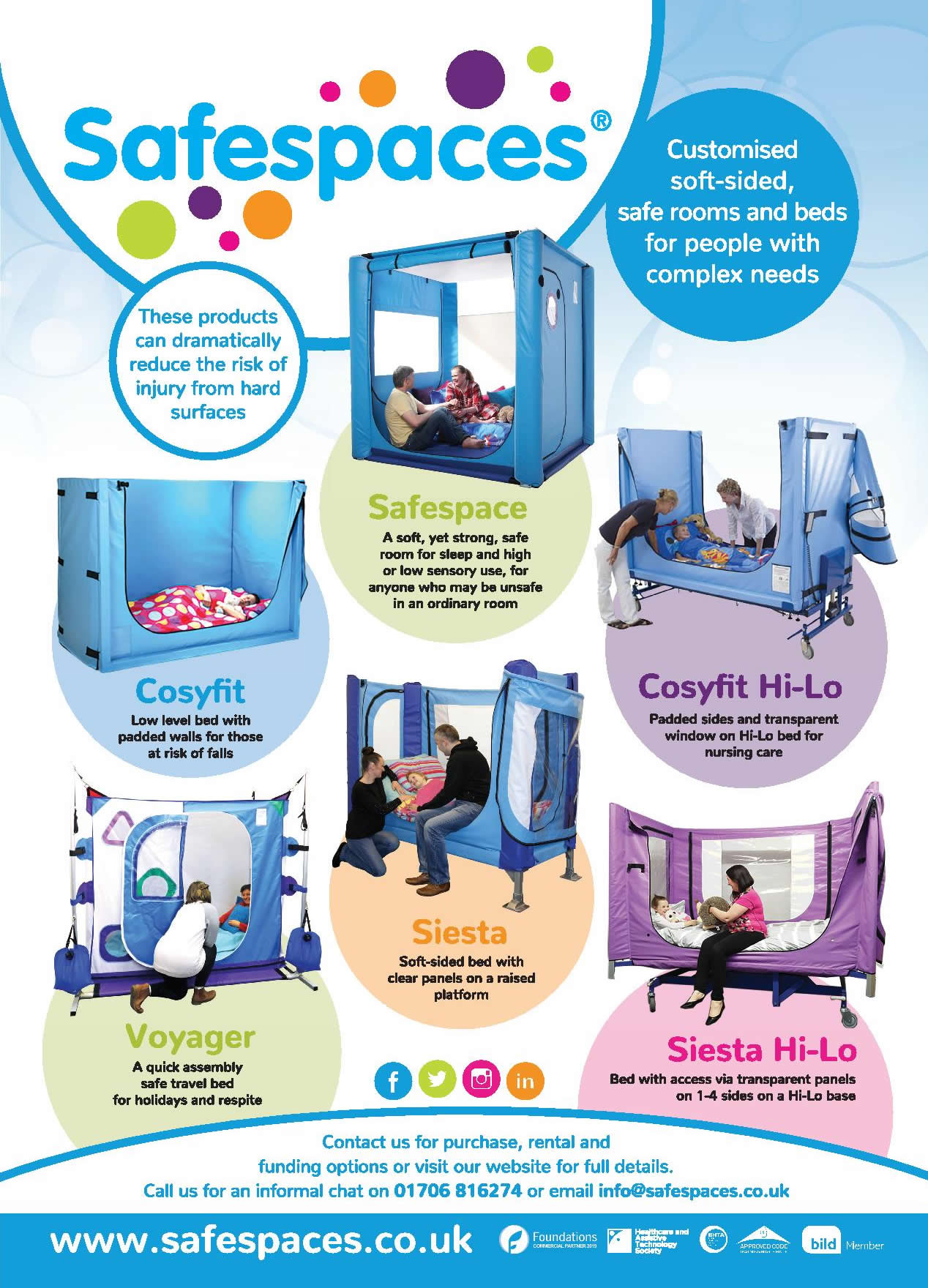

Your personal information is required in order to claim Gift Aid. This information is kept by DLF/Shaw Trust for financial audit purposes. For more information on our privacy policy visit: https://www.dlf.org.uk/content/privacy-policy










